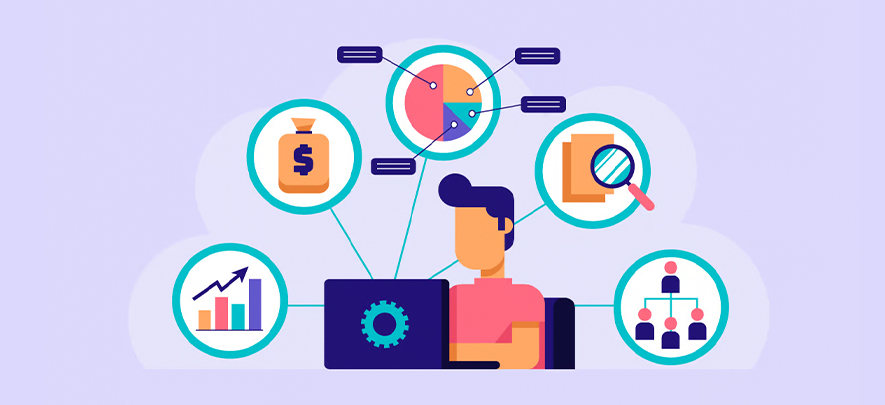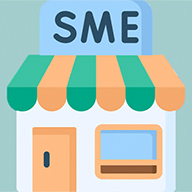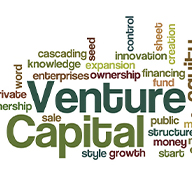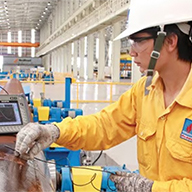ERP – Overview of the Basic Modules for SMEs 2023

Digital & Technology
97 week ago — 12 min read
Along with the development of the 4.0 era, many businesses, including SMEs, are gradually evolving with digital transformation solutions. ERP – enterprise resource planning solutions, has become a familiar phrase. However, knowledge about ERP and its modules is still very vague and limited. According to our survey and relevant reports, the majority of SMEs in Vietnam have only applied financial accounting software. When asked, SMEs often link digital transformation and ERP applications in businesses with financial accounting solutions. However, ERP covers multi areas, and financial accounting is just one of them. So, what are the basic modules of ERP? Or, besides the financial accounting module, what other basic modules does ERP include? Let's find out with GroBanc in this article!
What is ERP?
ERP is the abbreviation of Enterprise Resource Planning. ERP solutions are usually provided as a multi-module software application system that can apply to the whole enterprise. A module is a group of features with supporting functions for a specific business area or department in the company. The modules will be integrated, operating on the same platform, creating a unified and transparent database. This allows different business departments to share, update and access information from a shared system, reducing errors when using separate software and simplifying cumbersome and complicated processes. It can be seen that ERP helps improve the efficiency of data management, planning and decision-making in daily operations, ensuring accuracy, thereby reducing costs and increasing profits for businesses.
With SMEs, their ERP system includes many modules with different features corresponding to specific functions and departments. The needs for ERP modules will vary based on the size, operations and other characteristics of the organization, but the basic ERP modules are similar across businesses. Let's find out these basic modules with GroBanc!
1. Finance - Accounting module
The Finance - Accounting module is probably the first module that SMEs think of when mentioning ERP and considering applying digital transformation for their business. The Finance-Accounting module is considered the most important ERP module, managing capital, and cash flow in and out. The Finance-Accounting module includes these main functions: tracking payables, and receivables; automating the invoice and payment; account reconciliation; making reports, developing financial allocation plans; controlling cost based on budget; etc.
The relevant data of departments and divisions in the enterprise will be collected and stored on other modules such as Purchasing, Production, etc., on the same system, helping the Finance-Accounting department reduce data entry time and cumbersome bookkeeping tasks as in the past, as well as ensures accuracy and speed up the payment process. In addition, the storage on a shared system enables managers to understand the financial health of the business, thereby making appropriate strategic plans.
2. Purchasing module (Procurement Module)
The Purchasing module undertakes the procurement processes of goods or materials necessary for production and daily business activities. The Purchasing module includes functions such as setting up and storing approved supplier lists; categorizing suppliers with specific items; making and sending enquiries; receiving and archiving reports; analyzing quotations; preparing and dispatching orders; tracking orders; automatically updating inventory upon delivery.
The Purchasing module manages the relationship with suppliers, helping the purchasing department quickly target the right supplier when there is a shortage of goods or new arising demands. In addition, supervising the entire purchasing process from placing an order, and delivery of the goods to the time the goods arrived at the warehouse, allows other departments to control the whole process easily, thereby planning to allocate resources for production and business activities in a reasonable manner and promptly solve arising problems.
3. Manufacturing module
As the name conveys, the Manufacturing module is an indispensable module for manufacturing and processing SMEs. This module is in charge of functions such as production planning; resource allocation, and use of machinery, raw materials, devices, tools, and components, ensuring that the enterprise has the necessary resources for its production activities.
During the production process, the module will update the manufacturing progress continuously in real-time. Semi-finished products and finished products will also be reported in the system's report. Based on the data, the module will calculate the production time, control and compare the actual output with the forecasted productivity to report timely and plan accordingly.
Normally, the Material Requirements Planning (MRP) and Manufacturing Execution System (MES) will be integrated with the Manufacturing module. However, for manufacturing enterprises with more complex and specific processes, these two functions will be divided into separate modules.
4. Inventory Management module
The Inventory Management module controls the inventory (including raw materials for production and goods) by storing and updating real-time data on quantity, item code, location, unit, and warehouse for each category of goods. The module also controls daily receipts, pricing inbound and outbound inventory, updating quantities based on procurement and orders, making forecasts, etc. Along with the Purchasing module, the Inventory Management module provides an overview of out-of-stock, goods availability, and upcoming arrived goods.
The Inventory Management module ensures that the enterprise has an optimal amount of inventory for production and sales, avoiding wasting money on purchasing unnecessary inventory. It also helps save significant storage costs. In addition, tracking inventory through input and output regularly will provide an overview of customers' purchasing trends, thereby assisting in effective inventory turnover planning with an optimal budget, and minimizing shortages with trending product models.
5. Sales Module (Order Management module)
The Sales module (also known as the Order Management module) is for order management, with basic processes such as analysis and processing of order requests from customers; accepting orders; issuing invoices; preparing goods; connecting with the carrier to deliver the goods; tracking orders being delivered; updating status when order successfully delivered.
The Sales module may also include functionality that suggests the most cost-effective option for order fulfilment—for example, determining the distance of warehouses from stores or distributors, or based on distance from the buyer's location.
Tracking orders from the time they are generated and received by the system until they are successfully delivered helps to increase the rate of on-time delivery, minimize loss, and reduce unnecessary costs for urgent shipping. At the management level, the Sales module assists in monitoring the sales situation in real-time, supporting the management of all sales channels and improving the customer experience.
6. Customer Relationship Management (CRM) module
In the Customer Relationship Management (CRM) module, all details about customers and prospects (leads) including contact history, calls, email exchanges, messages, meetings, purchase history, contract duration, etc. will be stored. This module allows different departments to easily access the information they need when working with customers, helping to improve sales performance through better customer service and building positive relationships with customers.
With existing customers, besides customer data, the CRM module also supports after-sales services such as customer care, reminders to periodically inquire, online consultation, etc. With potential customers, the CRM module helps create customer segments, support analysis and develop appropriate strategies, hence increasing conversion rates. The module keeps track of the prospects list with contact information and offers various suggestions to have a better chance of reaching customers, such as identifying target customer groups that are suitable for different promotions or certain products. To increase sales opportunities, many businesses also integrate the CRM module with the Sales module.
7. Human Resource Management (HRM) module
Considered a CRM module for employees, the Human Resource Management (HRM) module has the function of managing and storing all relevant data about SMEs' employees such as personnel records, employment contracts, job descriptions, welfare, performance evaluation, timekeeping, payroll, overtime report, leave report, etc. Regarding the payroll function, the module will automatically distribute salary and allowances to employees according to the salary schedule with corresponding taxes deduction. When integrated with the Finance-Accounting module, the HRM module will provide payment reports, payroll expense reports, allowances, overtime bonuses and other reports related to other employee costs.
Until now, many enterprises in Vietnam, especially SMEs, have created their own records and data systems manually, making statistics difficult and leading to potential errors. The HRM module with a systematically designed information storage and aggregation system is in charge of storing a large amount of information about all employees throughout the organization, eliminating duplicate, inconsistent and inaccurate data, thereby improving management efficiency.
Above are 7 basic modules of ERP. Each module is responsible for specific functions corresponding to the activities of departments and divisions such as the Finance - Accounting Department, Human Resources Department, Sales Department, etc. The ease and convenience of linking and integrating modules, as well as storing data on a shared system, providing real-time information and automating business activities are the advantages of the ERP software system. SMEs can change, add, remove, and develop modules based on the needs and development of their business at different periods. Through this article, hope that GroBanc can help businesses, especially SMEs, have an overview of ERP as well as basic ERP modules and their functions.
As a Finance and Growth Hub for SMEs, GroBanc is not only limited to financial solutions, but also provides SMEs with simple, easy-to-use, yet optimal effective ERP solutions that support business operations and resource allocation, maximising the profit of their business.
GroBanc – The Finance and Growth Hub for SMEs
To explore business opportunities, link with me by clicking on the 'Connect' button on my eBiz Card.
View Linh 's profile
Most read this week
Trending
Get Efficient at Taking Decisions
Lãnh đạo & Quản lý 14 week ago
The Art & Science of People Pleasing in Retail
Bán lẻ 17 week ago
Khởi nghiệp 17 week ago















Comments
Share this content
Please login or Register to join the discussion